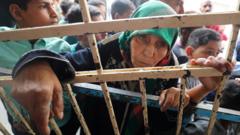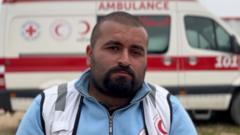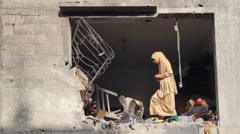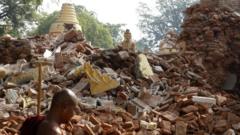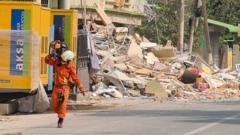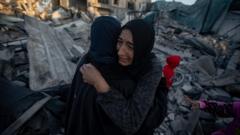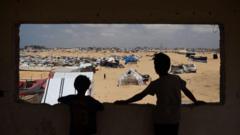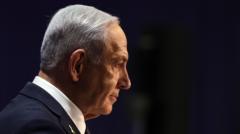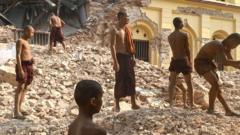Recent findings indicate that the Gaza area identified as a "humanitarian zone" by Israel's military has experienced significant bombardment, casting doubt on its safety amidst ongoing conflict and leading to heightened concerns for civilians.
Ongoing Strikes in Gaza's 'Humanitarian Zone' Raise Alarms Amid Ceasefire Talks
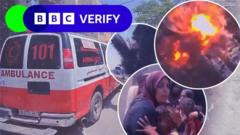
Ongoing Strikes in Gaza's 'Humanitarian Zone' Raise Alarms Amid Ceasefire Talks
Analysis reveals nearly 100 strikes have targeted a designated safety area in Gaza, complicating humanitarian efforts as ceasefire negotiations progress.
The area in Gaza that Israel designated as a "humanitarian zone" to protect civilians has been struck nearly 100 times since May 2024, according to an analysis by BBC Verify. As negotiations for a ceasefire between Israel and Hamas progress, these findings raise critical concerns about civilian safety and the effectiveness of humanitarian protections in conflict zones.
Established in October 2023 by the Israel Defense Forces (IDF), the "humanitarian zone" aimed to provide a safe haven for civilians amid ongoing military operations. It was expanded in May 2024 to cover populated areas such as Khan Younis and Deir al-Balah, where over a million people currently reside in dire conditions with limited access to aid, according to international humanitarian organizations. Reports indicate that 550 fatalities have resulted from the documented strikes.
In response to accusations regarding civilian safety, IDF officials claim they are targeting Hamas fighters who are allegedly using civilians as shields and launching operations from within the so-called safe area. Since the onset of the conflict following the October 7, 2023 attack by Hamas, which resulted in numerous casualties, the situation in Gaza has deteriorated significantly, with the Hamas-run health ministry reporting over 46,000 deaths due to the escalating violence.
Incidents of strikes appear to have intensified, especially in the month of January 2024, with local humanitarian organizations reporting near-daily bombardments from various military assets. Gavin Kelleher, an access manager for the Norwegian Refugee Council, noted that the "humanitarian zone" has not offered true security to residents, who continue to face life-threatening circumstances.
Testimonies from individuals like Khaled Abdel Rahman highlight the pervasive fear and trauma experienced by residents, who thought they could find reprieve in the designated area. As the IDF does not allow independent foreign media access to Gaza, reports largely depend on material provided by Palestinian journalists and residents, leading to potential discrepancies in verifiable information.
BBC Verify's analysis tracked strikes using various social media channels and confirmed details with multimedia evidence. The review of over 300 related videos unveiled the tragic human cost of the strikes, including numerous civilian injuries and deaths, further emphasizing the risks posed by military operations in heavily populated areas.
Despite the IDF’s rationale of targeting militant infrastructures, the ambiguity surrounding evacuation orders and the fluctuating boundaries of the "humanitarian zone" cast doubt on its intended purpose. Juliette Touma from the UN agency for Palestinian refugees asserted that no area in Gaza can be deemed truly safe amidst such ongoing conflict.
Ultimately, while diplomatic efforts for a ceasefire may offer a glimmer of hope, the situation for civilians trapped within Gaza's "humanitarian zone" remains precarious, underscoring the complexities of war and the profound impact on human life.
Established in October 2023 by the Israel Defense Forces (IDF), the "humanitarian zone" aimed to provide a safe haven for civilians amid ongoing military operations. It was expanded in May 2024 to cover populated areas such as Khan Younis and Deir al-Balah, where over a million people currently reside in dire conditions with limited access to aid, according to international humanitarian organizations. Reports indicate that 550 fatalities have resulted from the documented strikes.
In response to accusations regarding civilian safety, IDF officials claim they are targeting Hamas fighters who are allegedly using civilians as shields and launching operations from within the so-called safe area. Since the onset of the conflict following the October 7, 2023 attack by Hamas, which resulted in numerous casualties, the situation in Gaza has deteriorated significantly, with the Hamas-run health ministry reporting over 46,000 deaths due to the escalating violence.
Incidents of strikes appear to have intensified, especially in the month of January 2024, with local humanitarian organizations reporting near-daily bombardments from various military assets. Gavin Kelleher, an access manager for the Norwegian Refugee Council, noted that the "humanitarian zone" has not offered true security to residents, who continue to face life-threatening circumstances.
Testimonies from individuals like Khaled Abdel Rahman highlight the pervasive fear and trauma experienced by residents, who thought they could find reprieve in the designated area. As the IDF does not allow independent foreign media access to Gaza, reports largely depend on material provided by Palestinian journalists and residents, leading to potential discrepancies in verifiable information.
BBC Verify's analysis tracked strikes using various social media channels and confirmed details with multimedia evidence. The review of over 300 related videos unveiled the tragic human cost of the strikes, including numerous civilian injuries and deaths, further emphasizing the risks posed by military operations in heavily populated areas.
Despite the IDF’s rationale of targeting militant infrastructures, the ambiguity surrounding evacuation orders and the fluctuating boundaries of the "humanitarian zone" cast doubt on its intended purpose. Juliette Touma from the UN agency for Palestinian refugees asserted that no area in Gaza can be deemed truly safe amidst such ongoing conflict.
Ultimately, while diplomatic efforts for a ceasefire may offer a glimmer of hope, the situation for civilians trapped within Gaza's "humanitarian zone" remains precarious, underscoring the complexities of war and the profound impact on human life.




